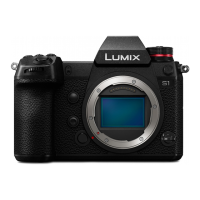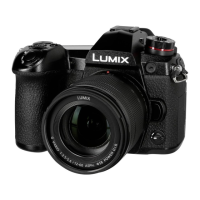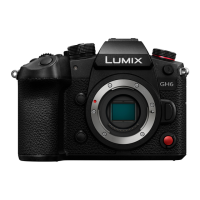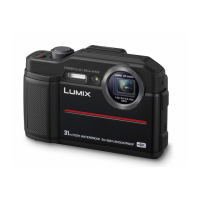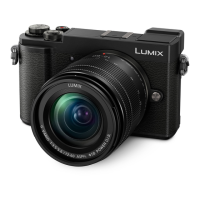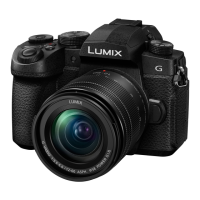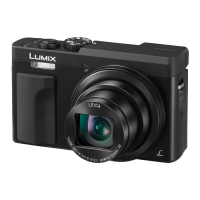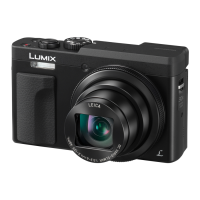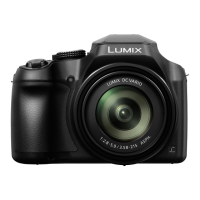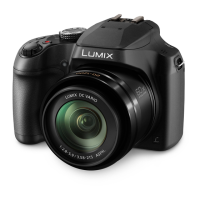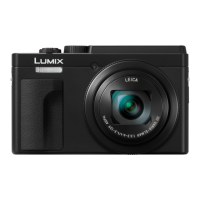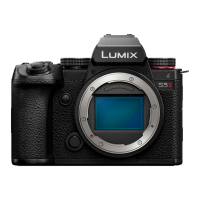
Do you have a question about the Panasonic LUMIX DC-S5M2 and is the answer not in the manual?
| Brand | Panasonic |
|---|---|
| Model | LUMIX DC-S5M2 |
| Category | Digital Camera |
| Language | English |
Explains icons used for function availability and conditions.
Explains camera operation symbols used in the manual.
Provides essential information and precautions before operating the camera.
Lists the items supplied with the camera upon purchase.
Details the types of interchangeable lenses compatible with the camera.
Specifies the types of memory cards supported by the camera.
Identifies and labels the various parts of the camera body and controls.
Step-by-step instructions on how to attach the camera's shoulder strap securely.
Explains how to charge the camera battery using the supplied AC adaptor or other methods.
Details the procedure for inserting memory cards into the camera's dual card slots.
Provides instructions on how to correctly attach interchangeable lenses to the camera body.
Explains how to adjust the camera's monitor for different shooting angles.
Guides the user through setting the camera's date, time, and time zone upon first use.
Demonstrates the proper way to hold the camera to minimize shake and ensure stable shooting.
Explains how to rotate the mode dial to choose between different shooting modes.
Introduces the main operational parts used for changing camera settings.
Covers settings related to customizing the information displayed on the monitor and in the viewfinder.
Explains how to quickly set frequently used functions without accessing the main menu.
Describes how to view and change current recording settings using the monitor.
Details how to navigate and operate the camera's menu system using various controls.
Provides steps for entering text characters on the camera, such as for naming files.
Explains how the camera automatically selects optimal settings based on the scene.
Describes how to use touch operations for focusing, shutter release, and exposure adjustments.
Covers fundamental steps for taking still pictures, including selecting modes and adjusting focus.
Explains how to select the desired image aspect ratio for photos.
Details how to set the image size for photos, which varies by aspect ratio and lens.
Allows setting the compression rate for storing pictures, affecting image quality and file size.
Covers fundamental steps for starting, stopping, and managing video recording.
Explains how to change the system frequency for recorded and playback videos, affecting compatibility with broadcast systems.
Allows selection of the video file format (MP4 or MOV) for playback on PCs or image editing.
Sets the image quality for videos, depending on recording mode, system frequency, and file format.
Sets the image area for video recording, affecting the angle of view and enabling telescopic effects.
Explains how to select the appropriate focusing method (AFS, AFC, MF) for different subjects and movements.
Covers automatic focusing operations, including setting focus modes and using AF detection.
Details how to choose the AF mode that best matches the subject's position and number.
Explains how to move, change the size, and reset the AF area for precise focusing.
Guides the user on performing manual focusing, including using focus peaking and MF guide.
Explains how to use the optical zoom and extended tele conversion for enhancing telescopic effects.
Explains how to switch the drive mode for single shots, bursts, self-timers, etc.
Details how to capture continuous pictures using various burst shooting settings and rates.
Describes how to merge multiple images to create a single image with higher resolution.
Explains how to take pictures automatically at set intervals to capture changes over time.
Guides on taking pictures sequentially while moving subjects to create stop motion videos.
Covers how to use the self-timer for delayed shooting to avoid camera shake.
Explains how to record multiple images with automatic changes in exposure, aperture, focus, or white balance.
Disables operation sounds and light output for discreet shooting.
Allows selection of the shutter type (mechanical, electronic front curtain, electronic) for taking pictures.
Explains the in-body and in-lens image stabilization systems and their compatibility.
Allows changing the type of optical measurement used to determine brightness.
Explains how the camera automatically sets shutter speed and aperture for brightness.
Details how to set the aperture value before recording, with the camera automatically setting shutter speed.
Explains how to set the shutter speed before recording, with the camera automatically setting aperture value.
Covers recording by manually setting aperture value and shutter speed, with ISO sensitivity often set to AUTO.
Allows checking the effects of aperture and shutter speed on the recording screen.
Explains how to compensate exposure when the camera's standard exposure is too bright or too dark.
Describes how to lock focus and exposure settings for consistent composition while changing framing.
Covers setting the light sensitivity (ISO sensitivity) of the camera.
Explains how to correct color cast from lighting to make white objects appear white.
Allows selecting finishing settings for images to match subjects and expression styles, with adjustable image quality.
Describes how to apply additional image effects (filters) during recording.
Explains how to register LUT files for use with Photo Style and LUT View Assist.
Details compensation for lens characteristics like vignetting, color shading, and diffraction.
Explains how to attach and use external flash units for improved lighting.
Covers setting flash modes, manual adjustments, synchronization, and auto exposure compensation.
Describes how to control flash units wirelessly for flexible lighting setups.
Explains video-specific modes like Creative Video and Slow & Quick for different recording effects.
Details how to set continuous AF modes and custom settings for video focusing.
Covers adjusting luminance levels and color characteristics for video recording.
Explains settings for sound recording levels, gain, quality, mute, wind noise cancellation, and audio information.
Describes how to connect and use external microphones for higher quality audio recording.
Details the use of the XLR adapter for connecting professional microphones and recording 4-channel audio.
Covers connecting headphones for sound monitoring and adjusting volume levels.
Explains how to set, display, and output time codes for video recording.
Introduces various display assist functions like flicker decrease, waveform monitor, and zebra pattern.
Explains how to record videos at different frame rates for slow motion or quick motion effects.
Covers recording video at high frame rates for slow motion playback.
Describes how to smoothly transition focus between registered positions during recording.
Explains how to crop the live view image to create panning and zooming effects in 4K/FHD video.
Enables Log recording by setting Photo Style to V-Log for rich gradations in post-production.
Covers recording videos with the wide dynamic range of the HLG format for HDR display.
Details anamorphic recording capabilities, including desqueeze display and suitable image stabilizers.
Fine-tunes shutter speed to reduce flickering and horizontal stripes in video.
Allows continuous recording by deleting old data when the card is full, useful for long recordings.
Segments recorded video at set intervals to avoid data loss from power interruptions.
Provides a table of recording qualities compatible with Slow & Quick, High Frame Rate, Live Cropping, and HLG videos.
Guides on connecting the camera to external monitors or recorders using an HDMI cable.
Explains how image quality for HDMI output differs based on recording mode and settings.
Covers settings for outputting camera information, control information, audio, and enlarged live display via HDMI.
Explains how to display and navigate through still images in playback mode.
Details how to play, pause, stop, and control video playback.
Covers switching between enlarged display, thumbnail, and calendar views for image playback.
Explains how images recorded with specific modes like Time Lapse Shot are handled as group images.
Guides on how to delete selected images or entire groups of images.
Describes how to process RAW images on the camera and save them as JPEGs.
Lists the various options available within the playback menu for managing images and videos.
Explains how to register and use functions assigned to the Fn buttons for quick access.
Details how to temporarily change the functions operated by the front and rear dials.
Covers changing Quick menu items, their display order, and appearance to suit user preferences.
Explains how to register and use custom shooting modes (C1, C2, C3) for saving preferred settings.
Lists the various items available within the Custom menu for advanced settings.
Outlines the basic camera settings available in the Setup menu.
Describes how to register and manage frequently used menu items for personalized access.
Lists all menu items related to photo settings and their corresponding page numbers.
Lists all menu items related to video settings and their corresponding page numbers.
Lists all menu items related to camera customization and their corresponding page numbers.
Outlines the basic camera settings available in the Setup menu.
Lists all items registered in the My Menu for quick access.
Lists all menu items related to playback and editing functions and their corresponding page numbers.
Guides on connecting the camera to a smartphone using Wi-Fi or Bluetooth via the LUMIX Sync app.
Explains how to control camera functions like remote shooting and image transfer using a smartphone.
Details the process of sending recorded images from the camera to a PC via Wi-Fi.
Covers different methods for establishing Wi-Fi connections, including Via Network and Direct.
Describes how to set image size and file format for sending, and how to select images for transfer.
Configures settings for the Wi-Fi function, including password authentication and network addresses.
Explains how to connect the camera to external devices like TVs and PCs using HDMI or USB.
Guides on connecting the camera to a TV via HDMI to view recorded pictures and videos.
Details how to copy recorded images from the camera to a PC using USB connection and software.
Explains how to store pictures and videos on a Panasonic Blu-ray or DVD recorder.
Describes how to control the camera remotely from a PC via USB using LUMIX Tether software.
Lists compatible optional accessories and their product numbers.
Provides information on using accessories like battery grips, remote controls, and tripods.
Explains the benefits and features of the optional battery grip, including dust/splash resistance.
Details how to connect and use the shutter remote control for shake-free shooting and bulb/burst modes.
Describes attaching a tripod grip for stability during walking, tripod use, or remote control.
Explains how to use AC adapters and DC couplers for continuous power supply.
Provides examples and explanations of icons and information displayed on the camera's monitor and viewfinder.
Explains the meaning of various camera messages and provides response methods.
Offers solutions for common issues related to power, recording, playback, flash, Wi-Fi, and other functions.
Provides important warnings and precautions for safe and proper use of the camera and its accessories.
Lists the approximate number of pictures and video recording times based on battery usage.
Provides estimated numbers of pictures and video recording times based on card capacity and format.
Lists default settings and details about custom saving and copying settings for the camera.
Shows which functions can be set in each of the camera's recording modes (iA, P, A, S, M, etc.).
